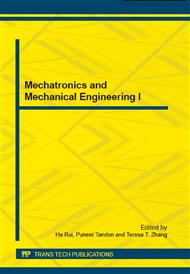[1]
P. Elisa, S. Carlos, L.M. Natalia, N. Oscar and M. Vicente: Vision- Based Interfaces Applied to Assistive Robots, International Journal of Advanced Robotic Systems, (2012).
Google Scholar
[2]
J.J. Michelle, F. Xin, M. J Laura, M.W. Jack: Potential of Suite of Robot/ Computer-Assisted Motivating System for Personalized, Home- Based, Stroke Rehabilitation, Journal of Neuroengineering and Rehabilitation, Vol. 4, No. 6, (2007).
DOI: 10.1186/1743-0003-4-6
Google Scholar
[3]
M. Muralindran and K. Brendan: Design and Development of Communication and Control Platform for Medical Tele-diagnosis Robot (MTR), International Journal of Networks and Communications, Vol. 3, No. 1, pp.12-20, (2013).
Google Scholar
[4]
M. Muralindran, N. Manimehala, R.P. Rosalyn, R. Vigneswaran and K. Brendan: A LabVIEW Design for Frontal and Non- Frontal Human Face Detection System in Complex Background, Applied Mechanics and Materials, Vol. 490- 491, pp.1259-1266, (2014).
DOI: 10.4028/www.scientific.net/amm.490-491.1259
Google Scholar
[5]
M. Muralindran, N. Manimehala and M. Karthigayan: LabVIEW Based Intelligent Frontal & Non- Frontal Face Recognition System, International Journal of Computer Science and Electronics Engineering, Vol. 1, Issue 1, p.136, (2013).
Google Scholar
[6]
V. Soumya and M. Sreeraj: Object Detection and Classification in Surveillance System, IEEE Recent Advances in Intelligent Computational Systems, p.299, (2013).
DOI: 10.1109/raics.2013.6745491
Google Scholar
[7]
X. Yu, Y. Yu, S. Yu, Y. Sang, H. Yang and X. Liu: A Novel Motion Object Detection Method Based on Improved Frame Difference and Improved Gaussian Mixture Model, 2013 2nd International Conference on Measurement, Information and Control, p.300, (2013).
DOI: 10.1109/mic.2013.6757972
Google Scholar
[8]
J. Deval, P. Shankar and S. Geetali: Real- Time Object Tracking using Color- Based Probability Matching, IEEE International Conference on Signal Processing, Computing and Control, pp.1-6 (2013).
DOI: 10.1109/ispcc.2013.6663399
Google Scholar
[9]
T. Du-Ming and L. Shia- Chih: Independent Component Analysis- Based Background Subtraction for Indoor Survelliance, IEEE Transaction on Image Processing, Vol. 18, No. 1, p.158, (2009).
DOI: 10.1109/tip.2008.2007558
Google Scholar
[10]
J. Qinghua and Y. Suping: Motion Detection Based on Adaptive Mixture Gaussian Model and Four- Frame Subtraction, 2013 International Conference on Computational and Information Sciences, p.1202, (2013).
DOI: 10.1109/iccis.2013.318
Google Scholar


